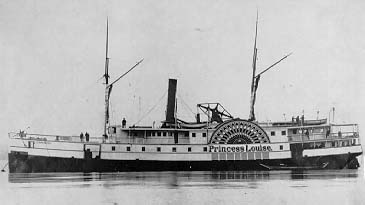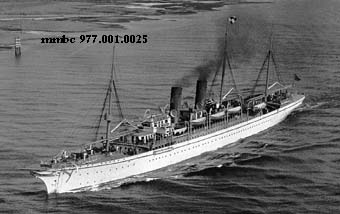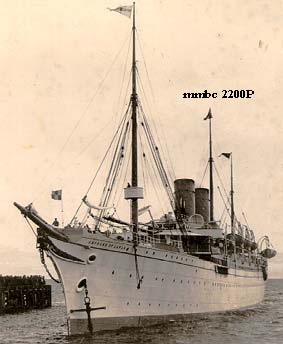
The first Princess Louise at anchor near Bella Coola
mmbc 4719.08
| During this time Canadian Pacific Navigation (C.P.N.) was operating sternwheelers such as the R.P. Rithet, sidewheelers such as the Princess Louise, and steamers such as the Otter in the Victoria, Vancouver and Puget Sound areas, extending transport to an d from these new rail links. |
 The first Princess Louise at anchor near Bella Coola mmbc 4719.08 |
| The first of the C.P.R. vessels to sail across the Pacific to the Orient were the Empresses: China, India and Japan. Hundreds of people (many were immigrants) arrived in the ports of Vancouver and Victoria on these liners, continuing their travels either east or south by C.P. rail or ship, and vacationing in the chain of hotels that C.P.R. provided from coast to coast. The Empress Hotel in Victoria is the last western C.P.R. hotel link in this chain. In supplying all of these services, C.P.R. has made considerable contributions to the growth of tourism in British Columbia. |
 Empress of China in Vancouver 1891 mmbc 977.001.0025  Empress of India 1891 mmbc 5026.03P |
The Empresses were designed for simple conversion to armed merchant cruisers and they served on every ocean in W.W.II. During this time, two Empresses were lost and one was destroyed. The Empresses were efficient and elegant liners that provided exception
al service for fifty years.

 C.P.R. S.S. Princess Victoria mmbc 988.20.1P |
When the C.P.R. took over the C.P.N. in 1901 several intercity and coastal vessels were added to the northwest coast fleet. These vessels were faster and were built with the latest technologies. The Princess line was born at this time and these new vessel s traveled an expanded route from Puget Sound, along the coast of British Columbia, to Lynn Canal in Alaska. |
 C.P.R. S.S. Princess Charlotte mmbc 988.20.2P |
 C.P.R. S.S. Princess Kathleen mmbc 988.20.3P |

![[English]](../simages/english.gif)
|

![[French]](../simages/french.gif)
|

![[Credits]](../simages/credit.gif)
|

![[Feedback]](../simages/feedback.gif)
|